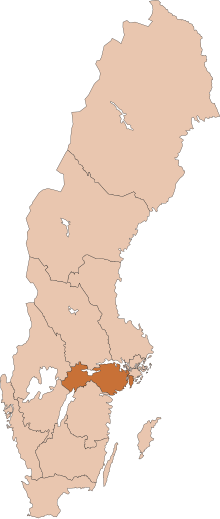Diocese of Strängnäs
Diocese of Strängnäs Diocesis Stregnensis Strängnäs stift | |
|---|---|
| Statistics | |
| Parishes | 62[1] |
| Congregations | 73[1] |
| Information | |
| Denomination | Church of Sweden |
| Established | around 1100[2] |
| Cathedral | Strängnäs Cathedral |
| Current leadership | |
| Bishop | Johan Dalman[3] |
| Map | |
 | |
| Website | |
| svenskakyrkan.se/strangnasstift | |
The Diocese of Strängnäs (
The diocese was first a Latin Catholic
Catholic Diocese
Missionary Antecedents
In 829
Pre-Reformation bishops
Late legend has it that Saint Eskil, an English bishop, disturbed a heathen sacrifice held at Strängnäs by king
He was succeeded by Bishop William (1160–1208). In 1160 the
The see lay vacant for nine years, but in 1233 Bishop Trogil was elected. About this time the
The poet
His successor, Matthias Gregerson Lilje, was the protector of "the Swedish Luther",
Cathedral and institutions
The cathedral of Strängnäs with its numerous chapels, one of which now contains a fine museum of ecclesiastical art, the bishop's palace, built about 1490, now the cathedral school, the fine Church of St. Nicholas at the interesting old town of Örebro, and numerous ancient village churches bear witness to the piety of the inhabitants in Catholic times.
Three provincial synods were held at Telge in the Diocese of Strängnäs in 1279, 1341 and 1380. The first two issued statutes on matters concerning the discipline of the clergy, while the synod of 1380 threatened with various penalties those who molested the tenants of church lands.
The "
Among other institutions, there was in the diocese the
Lutheran Reformation
King
The last Catholic bishop of Strängnäs, if he can be called so, was
See also
References
- ^ a b c "Det här är Strängnäs stift" (in Swedish). Church of Sweden. Retrieved 26 August 2011.
- ^ "Strängnäs stift". Nationalencyklopedin (in Swedish). Retrieved 26 August 2011. (subscription required)
- ^ "Biskopen i Strängnäs stift" (in Swedish). Church of Sweden. Archived from the original on 8 October 2012. Retrieved 26 August 2011.
Sources and external links
- Official website
 This article incorporates text from a publication now in the public domain: Herbermann, Charles, ed. (1913). "Ancient See of Strengnäs". Catholic Encyclopedia. New York: Robert Appleton Company.
This article incorporates text from a publication now in the public domain: Herbermann, Charles, ed. (1913). "Ancient See of Strengnäs". Catholic Encyclopedia. New York: Robert Appleton Company.


